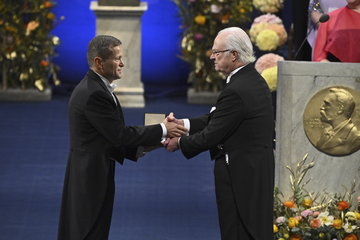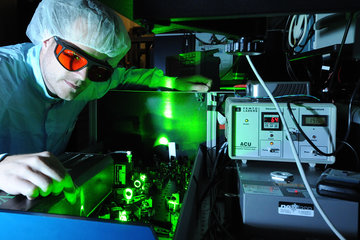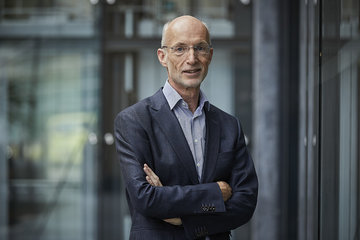Training atoms
Single atoms can’t be grasped through everyday experience: even a drop of water or a microorganism is made up of countless numbers of them. But Gerhard Rempe, Director at the Max Planck Institute for Quantum Optics in Garching, uses single atoms to study the interaction between light and matter at the most elementary level. The work that he and his team perform is creating the foundations for a future quantum internet.
Text: Roland Wengenmayr

The sun draws us outside on this fine afternoon. We are sitting in front of the cafeteria at the Max Planck Institute for Quantum Optics in Garching, near Munich. Gerhard Rempe clearly enjoys the campus atmosphere. Especially the warm sunlight feels good, and that brings us straight to the core of the physicist’s field of research. In order for us to be able to see the scenery around us, our eyes must receive light. The sun’s rays excite countless atoms to emit light, and atoms in the retinas of our eyes capture a portion of that light.
"The interaction between light and matter is utterly essential for our research," says Gerhard Rempe, kicking off the intellectual game that will gradually take us to the limits of current physics knowledge. It will cover the quantum world and its apparent peculiarities. We will discuss Schrödinger's cat, entangled quantum states and the question of how large such quantum objects can become. In other words, we will be concerned with how it might be possible to use quantum physics to build future quantum networks and quantum computers.
In Rempe’s division, young physicists are busy carrying out various experiments. However, one extreme experiment runs through Rempe’s research as a common – or, more appropriately – luminous thread. It involves two nearly perfect mirrors between which a single atom floats. "These are the best mirrors in the world," the Max Planck Director comments. The Garching-based scientists animate the atom in its mirror cabinet to either emit or absorb a single light quantum (photon). In other words, they reduce the process that occurs billions of times in the midday flood of light to its fundamental constituent. In experimental physics, radical reduction is a key to new discoveries. But why an atom and a photon?
This seemingly simple arrangement makes it possible to study "very, very" fascinating properties of quantum systems in their purest form, emphasizes Gerhard Rempe: "Such small systems allow one to penetrate into areas of quantum physics that are not accessible to large systems." Experiments with many atoms always reveal only average properties of large ensembles – just as one can't hear a single violin in an orchestra. But such a pure "sound" is what, figuratively speaking, physicists want to explore when they use a single atom to examine elementary quantum systems. In this way, they learn how the quantum building blocks of nature work. Their findings will thus pave the way to a future quantum information technology.
A cabinet with two supermirrors
Furthermore, with sophisticated experiments, they can take the game between single atoms and photons to its extreme. "And we do want to play," says Rempe. "That’s the only way basic research will work." The scientists in Garching have, indeed, made some exciting observations in this fundamental field that made Max Planck and Albert Einstein the discoverers of the quantum world more than a hundred years ago.
But how does one get a single atom to float between two mirrors? Christian Nölleke, a doctoral student who works in Tempe's department, explains this in the lab: "First, we produce a cloud of up to a million rubidium atoms." The physicists capture these atoms with a magneto-optical trap – that is, with laser light and magnetic fields – and largely freeze their motion. Since motion is synonymous with temperature, this cools the cloud to just above absolute zero, or minus 273.15 degrees Celsius. From this ultracold cloud, the physicists then use light tweezers to kick atoms between the mirrors. As soon as one reaches the resonator centre, the electronics captures it with light. "This takes just a few seconds," explains Nölleke.
And why are the mirrors so important? This question is of fundamental significance for Gerhard Rempe. "Such an atom is very small," he explains," and when I shine light on it from somewhere, my photons miss it entirely." This problem can be solved only by using the trick with the cabinet made of two mirrors. "When we look in the bathroom mirror, we have a pair of ourselves," says Rempe, "and if we then hold a second mirror behind us, many mirror images are created." The perfect mirrors in Garching could produce an incredible hundreds of thousands of mirror images, but no head would fit between them. They are spaced approximately a hundred micrometres (millionths of a meter) apart.

A photon is now tossed back and forth between these mirrors hundreds of thousands of times like a Ping-Pong ball. It will inevitably hit the atom eventually. Even if, conversely, the atom emits a photon, the resonator ensures welcome behaviour." For the luminous atom, due to its mirror images, it looks like hundreds of thousands of other luminous atoms there, all radiating light waves in exactly the same rhythm," says Rempe. This chain of virtual blinking quantum lights animates the atom to emit its photon precisely along this chain. This allows the Garching-based physicists to systematically find the extremely weak glow of the atom and work with it.
"This light is ideal, as it always consists of a single photon," says Rempe enthusiastically. "There are never zero or two photons." Many experimenters have racked their brains for years about how to obtain such single photon sources. Even extremely weak, pulsed lasers normally emit a randomly fluctuating number of light quanta per light pulse. Currently, only one atom between the mirrors can fire off exactly one photon at the push of a button, as it were. And only these light sources permit fundamental quantum operations like those required for a future quantum information technology.
"We’re known here as cavies," says Christian Sames, by way of introduction, as we stand in the lab in front of such a resonator experiment. The nickname is a play on the word "cavity". The doctoral student explains that the atom, together with the highly cultivated mirrors, forms a kind of molecule. What happens then can be understood if we recall that electrons in the atoms can absorb or emit light only in quantum jumps.
Like the strings of a musical instrument
These tiny quantum jumps occur between the steps of an energy ladder. The ladder forms because quantum particles such as electrons also exhibit wave properties. And the wave trains of the electrons must fit exactly around the atom: when closing this loop, a wave peak must merge into a valley without a jump.
In other words, the quantum states behave like the taut strings of a music instrument. In a molecule, the atom is now approached very closely by other atoms, which put the strings out of tune. In Garching, this is the function of the mirrors, instead, acting like the sound box of an instrument. In this way, they simulate a sort of molecule that consists, in part, of the atom, and in part of the light field between the mirrors.
With their single atoms in the resonator, the researchers can now tap the properties of their novel molecule –half atom, half-light – for novel applications. They can use it to systematically excite it, for instance with a laser beam, into the second quantum state, such that it then emits exactly two photons. In principle, this also works with three and more photons. "This gives us, for the first time, the possibility to use an atom to emit two photons, which normally doesn’t happen in nature," says Rempe.
Such sophisticated possibilities could spawn completely new components of a future quantum information technology – but just which one is not yet known even to quantum physicists. Even if it should involve quantum communication, Gerhard Rempe’s team is an international frontrunner. "Our goal is to one day build a quantum internet that sends, for example, quantum states," admits the scientist," or facilitates a quantum connection between two quantum computers, once such a thing comes into existence."
"We are particularly proud of the fact that we managed to get a very effective pair of laser light tweezers inside the narrow resonator," says Sames. After all, even a well cooled atom still moves a little and threatens to disappear from the resonator centre. Superfast control electronics detect this based on the weakening of the flow of single photons the atom emits. Then the light tweezers turn on briefly and push the drifting atom back again. Using this technique, the Max Planck physicists are now able to keep the atom trapped in the resonator for several minutes. "Our record is eight minutes– for our field, that is a short eternity," says Gerhard Rempe excitedly." It's the time light takes to get from the sun to the earth."
The researchers just achieved a further success that also demonstrates how the field is still very much in its infancy. Transferring quantum information on photons as flying quantum bits is almost routine today. What had not yet been solved, however, was the problem of storing the highly sensitive quantum information again, unharmed, in a resting quantum bit – and then later reading it out again, as is done on memory chips in conventional computers. Rempe’s team has now built the first such storage element. But why is that so difficult?
The challenge lies in the fact that it must be guaranteed that the extremely sensitive quantum information is transferred to the recipient unread. One can imagine this as something like a sealed letter that one must not even hold up to the light to decode words that show through the envelope. In the quantum world, even that would immediately destroy the entire message, leaving only the scraps of words that were glimpsed intact.
That is what distinguishes quantum bits – qubits for short – from conventional bits: the latter can be read and copied without loss. That is why one can, for example, easily transfer conventional bits from hard drives to light pulses that shoot through fibre-optic networks. But in quantum physics, reading and writing is usually a measurement process, which changes the information-bearing system. The reason for this is that a quantum system always simultaneously harbours multiple possibilities for realizing a certain physical variable. Conducting a measurement realizes one of these possibilities, but in doing so, it destroys all other variants. That is exactly what happens in a conventional copying operation.
Money in banks consists of bits
The quantum information must therefore be transferred under complete protection from curious observers. In quantum mechanics terms, an observer is essentially anything that influences the quantum system. Many kinds of perturbations from the environment are also the reason why the peculiar quantum effects don't normally make it onto the macroscopic scale of our everyday world– the world of large things.

This sensitivity of quantum information gave physicists the idea that it could be used as a key for absolutely secure communication. Any attempt at espionage would inevitably reveal itself in the collapse of the information. Gerhard Rempe thus sees this quantum communication as an interesting field of application for his research: "Money in banks, for example, invariably consists only of bits, and they must be protected."
Bank transfers have, in fact, already been quantum-cryptographically encrypted. One can even purchase commercial systems. To date, however, all of them have the problem that they can write the quantum information in photons once, as flying qubits – and at the end, read it out once. Then the information's destroyed. But in fibre-optic networks, photons don’t make it much farther than a hundred kilometres. Thereafter, at the latest, repeaters have to give the weakened pulses of light afresh boost. That’s how it works in the global fibre-optic networks. But since such a boost is also a measurement, it destroys the quantum information.
The key lies in the possibility to restore the quantum information from a flying qubit in a stationary qubit. Such a memory could then be further developed into a quantum repeater. Rempe’s team has, as the first in the world to do so, now succeeded in building a true cache memory. For this, they connected a single rubidium atom in a resonator via a 30-meter-long fibre-optic cable with an ultracold cloud of rubidium atoms. These approximately one million floating atoms form a large, collective quantum object known as a Bose-Einstein condensate. For the researchers in Garching, it served as cache memory. As quantum information, they used a quantum property of the electron in the single atom, namely the spin. This spin can be imagined as a small pointer. Using a laser Optics pulse, the team in Garching caused the atom to send a photon with this spin information through the fibre optics to the Bose-Einstein condensate.
There, a synchronized laser pulse stored this information in the cold atom cloud, thus distributing it across many atoms. Using a further laser pulse, the physicists perfectly released the stored photon from the atom cloud again. "The photon flew on beautifully in the same direction as before storage," says Rempe, clearly pleased. "We were surprised at how well that worked." So, in the transfer of sensitive quantum information between the single atom in the resonator and the Bose-Einstein condensate, a role was played by a quantum effect that has become the very symbol of the apparent madness of the quantum world: this entanglement formed, along the chain of transfer comprising the single atom, the photon and, ultimately, the ultracold atom cloud, a collective, extended quantum object. An entangled quantum object has peculiar properties. Its components –such as atoms and photons – can be very distant from one another. Nevertheless, all partners feel, with no time lag whatsoever, the moment certain quantum properties of even just one of them are manipulated. This seems to contradict the theory of relativity, which stipulates the speed of light as a strict limit for the propagation of physical interactions.
The cat in the box is alive or dead – or both
Quantum physics salvages this situation, as it always considers all system components together and never separately. There is therefore fundamentally no sending of information faster than the speed of light by entanglement transmission. Still, all of this runs so contrary to our everyday notion of a local physical reality that Albert Einstein took entanglement as proof of the incompleteness of quantum mechanics. Now it is clear: Quantum mechanics describes nature completely and correctly. Entangled quantum objects can be produced and used in technology. Moreover, quantum mechanics sets absolutely no theoretical limit for the extension of entangled objects, as long as they are shielded well enough from environmental perturbation.
Of course basic researchers like Gerhard Rempe want to test whether or not it is, in fact, possible to produce arbitrarily large quantum objects. The quantum-like connection between the single atom at one end of the fibre optics and the cold atom cloud at the other end is, in principle, also something that, in physics, is known as Schrödinger's cat. In 1935, Austrian physicist Erwin Schrödinger came up with the thought experiment in which an unstable atom, upon its radioactive decay, triggers a mechanism that poisons a cat. All of these components are located in a box. As long as the box remains closed, no one knows whether the cat is still alive or has already died. It isn’t possible to predict when the atom will decay, because chance has absolute reign over the quantum world. Thus, in the jargon of quantum physics, one can only record: as long as the box is closed, the two states –"cat is alive" and "cat is dead"– are superimposed.
With this exercise, Erwin Schrödinger wanted to show what consequences a direct connection between the micro world of quanta and our macro-world would have. What, at the time, was an intellectual game is now increasingly becoming a technological reality." In any case, our Bose-Einstein condensate already has a million atoms," stresses Rempe. Even if a cat is made up of considerably more atoms, perhaps that is only a slight difference.
However, the physicist points out that "The cat possesses awareness and should thus know whether it is still alive." This self-observation would be a measurement process that, according to the laws of quantum theory, should actually destroy the experiment. What would happen in reality remains unresolved.

Gerhard Rempe obviously enjoys contemplating potential limits of quantum physics. Now, however, he steers the conversation back to technology. Today, the Garching-based researchers successfully replaced the Bose-Einstein condensate with a second resonator with a single atom. Here, too, the storing of the photon-transferred quantum state worked, giving the mini-quantum network in Garching – the only one of its kind in the world – not just one, but two similar storage nodes.
That is a key step toward realizing Rempe’s dream of one day building a quantum internet. What all it could be used for, besides securely transmitting messages and connecting quantum computers, is still open. But the inventors of the laser also had to endure quite a bit of ridicule in the beginning– and still they initiated a technological revolution. Stepping out of the lab and back into the daylight, it seems like the hours have flown by. Gerhard Rempe offered some insight into the thought world of physicists who deal with quantum systems day in and day out. The result is a change of perspective.
"We play around with quantum physics a lot and we understand it well," says Rempe with a grin," so that we really doubt conventional physics. "But before the rug is completely pulled out from under the certainty regarding our everyday world, a loudly chirping bird brings us back to reality.













